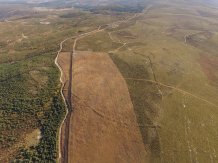Articles

Lomba-drone. Credit: Romanarmy.eu
Experts discover camp used by 10,000 Roman soldiers sent to conquer Northwest Iberia
Pioneering technology has helped experts find a lost camp built and used by thousands of Roman soldiers sent to conquer Northwest Iberia.
The discovery is the largest and oldest Roman military fortified enclosure excavated so far in Galicia and northern Portugal. The foundations of enclosure wall dates from around the second century BC.
Experts analysed a section of sediment from the wall’s foundations using optically stimulated luminescence (OSL) dating technique. This made it possible to date the last time the quartz crystals were exposed to sunlight and how long they were buried under the walls.
The discovery means Lomba do Mouro is the oldest scientifically identified Roman camp to date in Galicia and northern Portugal and may link its construction to the first Roman military campaigns in Gallaecia.
The camp of Lomba do Mouro, in Melgaço, Portugal, was constructed by around 10,000 Roman troops who were crossing the Laboreiro Mountain between the Lima and Minho rivers. It was designed to be a temporary fortification, used for a day or weeks at a most in the warmer months, and was built quickly.
The army was crossing on high ground for safety. Written sources describe fighting during their excursion, but also some potential agreements were made with the local community.
Temporary camps are hard to spot because little archaeological evidence is left behind – due to their non-permanent nature and because they were often destroyed on purpose when the Roman Army left.
Dr João Fonte, from the University of Exeter, a member of the research team, said: “Written sources mention the army crossing different valleys, but until now we didn’t know exactly where. Because of the temporary nature of the site, it’s almost impossible to find without using remote sensing techniques, and radiocarbon dating wouldn’t have been accurate because plant roots creep into the structure.”
“We have found numerous military camps in the Northwest of the Iberian Peninsula in recent years, but their dating is very complex. As they are temporary enclosures, there is very little material or organic evidence in them that would allow a scientifically valid dating to be obtained, until now.”
Covering more than 20 hectares, Lomba do Mouro was discovered using remote sensing techniques by the romanarmy.eu research collective and was subject of an archaeological survey in September 2020. The campaign was led by University of Exeter archaeologist João Fonte as part of the Finisterrae project funded by the European Commission through a Marie Skłodowska-Curie grant (grant agreement 794048).
Until now the oldest dated Roman camp in Galicia and northern Portugal - excavated by the same team - was Penedo dos Lobos (Manzaneda, Ourense), where coins could be found linking this enclosure with the war campaigns known as the Cantabrian Wars (29-19 BC), with which the Emperor Octavian Augustus put an end to the process of conquest of Hispania. Lomba do Mouro was built a hundred years before Penedo dos Lobos.
In 137 BC the Roman consul Decimus Junius Brutus entered Gallaecia with two legions, crossing the rivers Douro and Lima and reaching the Minho. The dating of the walls, together with the large dimensions of the enclosure, support the hypothesis that the camp may have been erected by a contingent linked to these times, although due to the degree of uncertainty of the dates it is difficult to establish a direct association with the episode of Decimus Junius Brutus campaign.
Romanarmy.eu has produced a documentary that explains the new discoveries and can be viewed on the research group's YouTube channel (https://youtu.be/fXGZVPHf3Oc) and on this website. The documentary is filmed in English and has subtitles in Galician, Portuguese and Spanish.
Romanarmy.eu is a scientific collective that investigates the Roman military presence in the Northwest of the Iberian Peninsula, made up of researchers from different European universities and research centres, different disciplines and specialists in different historical periods. Its publications, members and activities can be consulted at http://romanarmy.eu/en/.
Date: 24 June 2021
